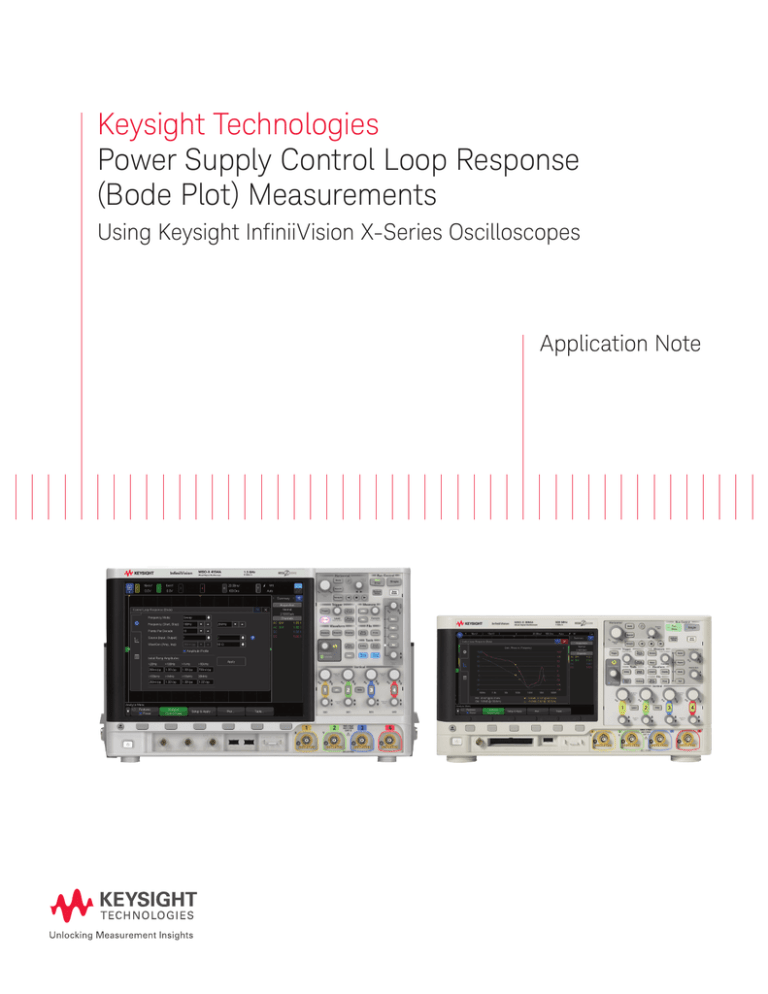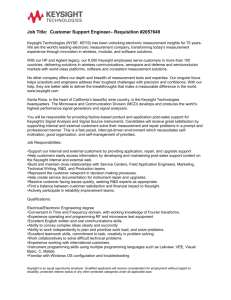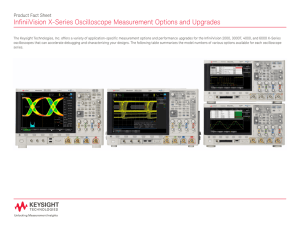Power Supply Control Loop Response (Bode Plot
advertisement

Keysight Technologies Power Supply Control Loop Response (Bode Plot) Measurements Using Keysight InfiniiVision X-Series Oscilloscopes Application Note Introduction The primary measurement tool used to test and characterize power supplies is an oscilloscope. Many of today’s scopes, including the Keysight Technologies, Inc. InfiniiVision X-Series, offer special power measurement options that can help automate many of the most important measurements. Figure 1 shows a list of the power supply characterization measurements that are available on Keysight’s InfiniiVision 3000T, 4000, and 6000 X-Series oscilloscopes with the power measurements option (DSOX3PWR, DSOX4PWR, DSOX6PWR). Unique to Keysight’s portfolio of measurements are frequency response measurements including control loop response (Bode) and power supply rejection ratio (PSRR). These particular stimulusresponse type measurements are typically performed using low-frequency network analyzers. But since Keysight’s InfiniiVision X-Series oscilloscopes come with a built-in function/arbitrary waveform generator, they can also be performed using these scopes. Figure 1. Power supply characterization measurements available in Keysight’s InfiniiVision X-Series oscilloscopes. 03 | Keysight | Power Supply Control Loop Response (Bode Plot) Measurements - Application Note Control Loop Response (Bode) A power supply is actually an amplifier with a negative feedback control loop as shown in Figure 2. This means that although you may think of a power supply as a DC amplifier, it actually amplifies AC to react to changes in output conditions, such as load changes. Performing a control loop response test requires that you inject an error signal over a band of frequencies into the feedback path of the control loop. The resistive-divider network of R1 and R2 is the feedback path in this diagram. To inject an error signal, a small resistor must be inserted into the feedback loop. The 5-Ω injection resistor shown in this schematic is insignificant in comparison to the series impedance of R1 and R2. So you might consider designing in this low-value injection resistor (Rinj) permanently for test purposes. An injection transformer, such as Picotest’s J2101A, is also required so that the AC disturbance signal is isolated and does not induce any DC bias. The measurement system, in this case an InfiniiVision X-Series oscilloscope with its built-in WaveGen function/AWG generator, measures AC voltage levels at the top of the feedback network (Vin) as well as at the regulated DC output (Vout) of the power supply. The scope then computes gain as 20Log(Vout/Vin) at each frequency within the swept band. Also measured at the same time is the phase difference between Vin and Vout. Figure 2. Power supply closed loop feedback network and oscilloscope connections for a control loop response test. 04 | Keysight | Power Supply Control Loop Response (Bode Plot) Measurements - Application Note Probing the Input and Output Good probing techniques are often required for control loop response measurements. Peak-topeak amplitudes of both Vin and Vout can be very low at some test frequencies and will often be buried in either the scope’s noise floor and/or buried in switching noise of the DUT itself. Increasing the signal-to-noise ratio (SNR) of your measurements will improve the dynamic range of your frequency response measurements. Although most scopes come standard with 10:1 passive probes, using 1:1 passive probes can reduce the effects of switching noise and thereby improve SNR. Keysight Technologies, Inc. recommends the N2870A 35-MHz bandwidth 1:1 passive probes. Reducing the length of your probe’s ground connection can also be beneficial. The standard ground lead of your probe can sometimes act as an antenna when in the vicinity of switching noise. If there is a ground post near the Vin and Vout test points, you can remove the long ground lead, as well as the probe grabber assembly, and simply lean the barrel of the probe, which is ground, against the ground post as shown in Figure 3. If there is not a nearby ground post but there is a close grounding point on your PCB, a short ground connection can often be achieved by using a spring ground clip accessory that comes with your passive probe. Another option is to design probe sockets into your PCB. This will provide the absolute best low-noise ground connection and also provide for hands-free probing. Figure 3. Probing your DUT with short ground leads will provide the best signal-to-noise ratio control loop response measurements. 05 | Keysight | Power Supply Control Loop Response (Bode Plot) Measurements - Application Note Performing the Control Loop Response Measurement Figure 4 shows a control loop response test setup on a Picotest switch mode power supply (SMPS) evaluation board using 1:1 passive probes with standard ground leads. The isolation transformer used in this test is a Picotest N2101A injection transformer. This SMPS design has a 5-Ω shunt/injection resistor designed into the feedback path of the control loop. Figure 4. Control loop response test setup using a Picotest J2101A injection transformer. 06 | Keysight | Power Supply Control Loop Response (Bode Plot) Measurements - Application Note Performing the Control Loop Response Measurement (Continued) To perform this control loop response test using an InfiniiVision X-Series oscilloscope with the power measurements option, first select the Control Loop Response measurement from the list of possible power supply related measurements, and then select the Setup & Apply menu shown in Figure 5. We will begin this measurement using all default settings, which includes a fixed test amplitude across all frequencies of 200 mVpp relative to a 50-Ω termination. Since our 1:1 isolation transformer is terminated into just 5-Ω, the actual differential test voltage across the shunt resistor will be closer to 36 mVpp (~13 mVrms). Figure 5. Establishing the control loop response test parameters. Note that most standalone frequency response analyzers (FRAs) and/or vector network analyzers (VNAs) set test amplitudes in terms of Vrms relative to a 50-Ω termination or in terms of dBm. If you plan to compare test results across multiple instruments (scope, FRA, VNA), make sure the test amplitudes are the same even though their settable units may be different (Vpp, Vrms, dBm). After establishing test parameters in the Setup menu, press Apply. In Figure 6, the teal trace shows the gain plot while the orange trace shows the phase plot across the test sweep from 100 Hz up to 20 MHz. The scope also automatically provides the phase margin (PM) and gain margin (GM) measurements at the bottom of the display. 07 | Keysight | Power Supply Control Loop Response (Bode Plot) Measurements - Application Note Performing the Control Loop Response Measurement (Continued) Figure 6. The control loop response gain and phase plots using a fixed test amplitude. In this test we also see what appears to be “chatter” at the lower test frequencies. This chatter is evidence that our SNR may be too low at some test frequencies. One method of improving SNR is to simply increase the test amplitude at all frequencies. However, increased test amplitudes can sometimes induce distortion which can also produce incorrect 0 dB cross-over phase margin measurements. A better solution to improve SNR is to customize test amplitudes using the amplitude profile capability of this measurement tool shown in Figure 7. With amplitude profiling, you can test at lower amplitudes at frequencies where the DUT is sensitive, and test at higher amplitudes where it is less sensitive to distortion. Power supply feedback networks typically are most sensitive near the 0 dB cross-over frequency, which for this DUT is ~60 kHz. Figure 7. Using amplitude profiling to optimize signal-to-noise ratio. 08 | Keysight | Power Supply Control Loop Response (Bode Plot) Measurements - Application Note Performing the Control Loop Response Measurement (Continued) Figure 8 shows the control loop response gain and phase measurement based on using customized test amplitudes. Notice that the chatter due to insufficient signal-to-noise ratio has been significantly minimized. Figure 8. Gain and phase measurement using optimized test amplitudes. So how do you determine optimum test amplitude? Some engineers recommend beginning with a relatively high test amplitude, and then gradually reducing it with multiple test runs until the measured 0 dB cross-over frequency settles to a stable point. One advantage of Keysight’s scope-based solution is that you can often observe distortion during the test. If the input test sine wave begins to look loop-sided, clipped, or somewhat triangular in shape (non-sinusoidal), then you are probably encountering distortion due to overdriving your DUT. Optimizing test amplitudes to achieve the best dynamic range measurements is often an iterative process of running your frequency response measurements multiple times. With Keysight’s oscilloscope-based frequency response measurements, you typically will go through fewer iterations. Note that you also can perform a phase and gain measurement at a single frequency using Keysight’s oscilloscope-based solution. This allows you to run a test a single frequency, such as at a frequency near the expected 0 dB cross-over frequency, and then make manual amplitude and frequency adjustments within the scope’s WaveGen setup menu while visually monitoring repetitive time-domain waveforms on the oscilloscope’s display. For example, you might begin by running a complete full-sweep test with a low test fixed amplitude such as we showed in Figure 6 (200 mVpp into 50-Ω which translates into ~13 mVrms across the 5-Ω shunt/injection resistor) to determine the approximate 0 dB cross-over frequency. In that example we determined that the 0 dB cross-over frequency was approximately ~62 kHz. Then run a single test at just 62 kHz and begin increasing the test amplitude until you begin to observe distortion. Once you determine the maximum test amplitude near the 0 dB cross-over frequency, you can simply use that test amplitude at all frequencies. If you want to optimize test amplitudes further at lower and higher frequencies, you can run a few more tests at different frequencies in order to determine an optimized amplitude profile. 09 | Keysight | Power Supply Control Loop Response (Bode Plot) Measurements - Application Note Summary Oscilloscopes are the primary measurement tools used today by engineers to test and characterize their power supply designs. But most scopes have significant limitations when it comes to performing frequency response measurements such as control loop response. Keysight’s InfiniiVision X-Series oscilloscopes are the first scopes on the market that can perform a control loop response measurement automatically. Side-by-side testing with a Keysight network analyzer shows that the gain and phase measurements of the InfiniiVision X-Series oscilloscope track very closely. System Requirements A control loop response test on a Keysight InfiniiVision 3000T, 4000, 6000 X-Series oscilloscope requires that the scope be licensed with the power measurements option (DSOX3PWR, DSOX4PWR, DSOX6PWR). The WaveGen option is not required. The scope will automatically turn on the WaveGen for the one-time control loop response measurement. Two 1:1 passive probes, such as the N2870A, are recommended for probing the low-level input and output signals. Coupling and isolating the input disturbance signal from the scope’s WaveGen output into the power supply’s feedback network requires an isolation transform such as Picotest’s J2101A injection transformer. For more information about this product, contact Picotest at www.picotest.com. In addition to the above listed minimum system requirements, your 3000T or 4000 X-Series oscilloscope must be running on firmware version 4.08 or greater, and your 6000 X-Series oscilloscope must be running on firmware version 6.10 or greater. Related Literature Publication title InfiniiVision 3000T X-Series Oscilloscopes - Data Sheet InfiniiVision 4000 X-Series Oscilloscopes - Data Sheet InfiniiVision 6000 X-Series Oscilloscopes - Data Sheet DSOX3PWR/DSOX4PWR/DSOX6PWR Power Measurement Options - Data Sheet InfiniiVision Oscilloscope Probes and Accessories - Selection Guide Power Supply Rejection Ratio (PSRR) Measurements - Application Note Switch Mode Power Supply Measurements - Application Note Making Your Best Power Integrity Measurements - Application Note Tips and Techniques for Making Power Supply Noise Measurements with an Oscilloscope - Application Note Evaluating Oscilloscopes for Low-Power Measurements - Application Note New Probing Technology Enables High Sensitivity, Wide Dynamic Range Current Measurement – Application Note Publication number 5992-0140EN 5991-1103EN 5991-4087EN 5990-8869EN 5968-8153EN 5992-0594EN 5991-1117EN 5992-0493EN 5989-6755EN 5991-4268EN 5991-1951EN 10 | Keysight | Power Supply Control Loop Response (Bode Plot) Measurements - Application Note www.axiestandard.org AdvancedTCA® Extensions for Instrumentation and Test (AXIe) is an open standard that extends the AdvancedTCA for general purpose and semiconductor test. The business that became Keysight was a founding member of the AXIe consortium. ATCA®, AdvancedTCA®, and the ATCA logo are registered US trademarks of the PCI Industrial Computer Manufacturers Group. www.lxistandard.org LAN eXtensions for Instruments puts the power of Ethernet and the Web inside your test systems. The business that became Keysight was a founding member of the LXI consortium. www.pxisa.org PCI eXtensions for Instrumentation (PXI) modular instrumentation delivers a rugged, PC-based high-performance measurement and automation system. 11 | Keysight | Power Supply Control Loop Response (Bode Plot) Measurements - Application Note Evolving Our unique combination of hardware, software, support, and people can help you reach your next breakthrough. We are unlocking the future of technology. From Hewlett-Packard to Agilent to Keysight myKeysight www.keysight.com/find/mykeysight A personalized view into the information most relevant to you. Keysight Infoline www.keysight.com/find/Infoline Keysight’s insight to best in class information management. Free access to your Keysight equipment company reports and e-library. KEYSIGHT SERVICES Keysight Services www.keysight.com/find/service Our deep offering in design, test, and measurement services deploys an industry-leading array of people, processes, and tools. The result? We help you implement new technologies and engineer improved processes that lower costs. Three-Year Warranty www.keysight.com/find/ThreeYearWarranty Keysight’s committed to superior product quality and lower total cost of ownership. Keysight is the only test and measurement company with three-year warranty standard on all instruments, worldwide. And, we provide a one-year warranty on many accessories, calibration devices, systems and custom products. Keysight Assurance Plans www.keysight.com/find/AssurancePlans Up to ten years of protection and no budgetary surprises to ensure your instruments are operating to specification, so you can rely on accurate measurements. Keysight Channel Partners www.keysight.com/find/channelpartners Get the best of both worlds: Keysight’s measurement expertise and product breadth, combined with channel partner convenience. www.keysight.com/find/scopes-power For more information on Keysight Technologies’ products, applications or services, please contact your local Keysight office. The complete list is available at: www.keysight.com/find/contactus Americas Canada Brazil Mexico United States (877) 894 4414 55 11 3351 7010 001 800 254 2440 (800) 829 4444 Asia Pacific Australia China Hong Kong India Japan Korea Malaysia Singapore Taiwan Other AP Countries 1 800 629 485 800 810 0189 800 938 693 1 800 11 2626 0120 (421) 345 080 769 0800 1 800 888 848 1 800 375 8100 0800 047 866 (65) 6375 8100 Europe & Middle East Austria Belgium Finland France Germany Ireland Israel Italy Luxembourg Netherlands Russia Spain Sweden Switzerland United Kingdom 0800 001122 0800 58580 0800 523252 0805 980333 0800 6270999 1800 832700 1 809 343051 800 599100 +32 800 58580 0800 0233200 8800 5009286 800 000154 0200 882255 0800 805353 Opt. 1 (DE) Opt. 2 (FR) Opt. 3 (IT) 0800 0260637 For other unlisted countries: www.keysight.com/find/contactus (BP-06-08-16) DEKRA Certified ISO9001 Quality Management System www.keysight.com/go/quality Keysight Technologies, Inc. DEKRA Certified ISO 9001:2015 Quality Management System This information is subject to change without notice. © Keysight Technologies, 2015 - 2016 Published in USA, July 15, 2016 5992-0593EN www.keysight.com


